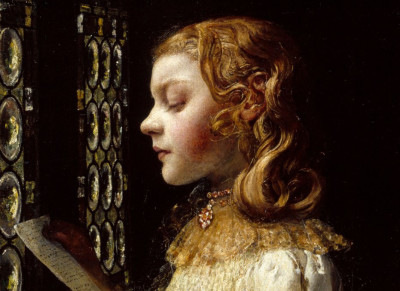How to read it: Frank Brangwyn’s ‘Sunflowers’
How to read it: Frank Brangwyn’s ‘Sunflowers’
By Helen Record
Published 18 June 2019
Frank Brangwyn’s ‘Sunflowers’ is an explosion of colour that captures the vibrancy of a much-loved plant. But did Brangwyn copy Van Gogh? And why sunflowers, anyway?
-
Florals? For spring? Groundbreaking
Frank Brangwyn RA was by no means innovative or daring in his choice of subject matter when he sat down to paint these flowers. Flower painting has a long and winding history in art throughout the centuries, stemming perhaps from the hugely popular Dutch master flower painters in the 17th century, such as Van Huysum and Bosschaert. Their fabulous and luscious blooms featured many different plants; most were native to the Low Countries, rich in tulips and hyacinths. The sunflower species, however, originated in North America and was only brought to Europe by Spanish explorers around 1500. By the 18th and 19th centuries, sunflowers were sufficiently widespread in Europe and painters could access them as inspirational subjects.
It goes without saying that Vincent Van Gogh is the art-historical king of sunflowers, but he is not the only artist with a soft spot for these plants. Many notable 19th and 20th-century painters used the sunflower motif: including Claude Monet and Paul Gauguin in France and Egon Schiele and Gustav Klimt in Austria. The increasing frequency of sunflowers in art may be linked to a highly practical development: the bright yellow pigment used to evoke the sunny petals was only developed in the early 19th century. From that moment on, painters continually returned to these characteristic plants, trying to convey their proud appearance through the medium of paint.
-

Sir Frank Brangwyn RA, Sunflowers, Early 20th century?.
Part of the RA CollectionOil on board. 755 mm x 632 mm. © The Artist's Estate. © Photo: Royal Academy of Arts, London. Photographer: John Hammond.
-
This painting is rooted in history, but Brangwyn replanted it in his own style
Brangwyn’s Sunflowers certainly builds on the tradition encapsulated by Van Gogh’s (in)famous paintings, yet Brangwyn reinterprets the subject through his own unique style. The focus of the painting is on colour and form, clearly-defined shapes interlocking across the canvas to construct the flowers and their ambiguous surroundings. While centrally this is a painting of sunflowers, the leaves and background dissolve into shapes and brushstrokes. The different brightness of the colours – the startling yellow petals versus the murky green leaves – illustrates Brangwyn’s fondness for assertive chiaroscuro (using contrasting patches of light and dark). This was a technique he added to his artistic armoury after visiting Spain, inspired by the intense light of the landscape. The pieced-together quality of Sunflowers is typical, with many of his early 20th-century works appearing ‘more like a mosaic pavement than a picture’ as one reviewer in the magazine Truth observed.
Sunflowers is perhaps also influenced by Brangwyn’s experience working as a designer for William Morris. Instead of the formal structured foliage he had trained into textile patterns, these plants are wild and free yet retain their decorative function. In Sunflowers, Brangwyn takes a popular trope and makes it his own, removing any sense of symbolic or emotional motive and instead sharing his appreciation of the explosive beauty of the sunflower plant.
-
He was a bit of a jet-setter
While we can’t put an exact date on this painting, we can be sure Brangwyn made it in the early 20th century, due to its bold colours and broad, assertive brushstrokes. Brangwyn only developed this style – which could be called ‘colourist’ – after travelling in the 1890s to places such as Spain, Turkey and South Africa. The sun-soaked landscapes of these regions, along with the influences of his artist-companions Arthur Melville and William Hunt, provided ample opportunity for the young Brangwyn to experiment with colour and enliven his previously sombre palette.
-

Sir Frank Brangwyn RA, The Market Stall, 1919.
Part of the RA CollectionOil on canvas. 1460 mm x 1600 mm. © The Artist's Estate. © Photo: Royal Academy of Arts, London. Photographer: John Hammond.
-
But Brangwyn wasn’t a one trick pony – he literally made thousands of artworks
Brangwyn was an artist who adhered to no single medium or style. He was outstandingly prolific, producing over 12,000 works of art across his lifetime. Still life, which includes flower painting, was just one of many genres he tackled with skill and energy. He not only painted landscapes and cityscapes, portraits and religious scenes but also undertook huge decorative schemes for public buildings such as the Royal Exchange in London and Christ’s Hospital School in Sussex. Brangwyn was similarly accomplished in print-making, including wood-engraving and lithography, and his designs for furniture and textiles were widely popular. He believed that a true artist ‘must turn his hand to everything’, a mantra that clearly informed his artistic practice.
Working across a range of media with such varied subject matter makes it hard to define Brangwyn’s artistic style. Yet across his oil paintings there is a sense of immediacy, of a world observed and transcribed through paint. His subjects are self-assuredly present, the compositions bold and the depictions honest. Often, as with Sunflowers, there is a semi-abstracted element, with Brangwyn breaking down what he sees into component shapes and colours. This tendency is visible in other works by Brangwyn in the RA Collection such as The Market Stall (1919) and Still Life with Fish (early 20th century).
-

Sir Frank Brangwyn RA, Still-life: Fish, Early 20th century?.
Part of the RA CollectionOil on canvas. 512 mm x 765 mm. © The Artist's Estate. © Photo: Royal Academy of Arts, London. Photographer: John Hammond.
-
Want to see ‘Sunflowers’? Well, don’t visit the RA…
Brangwyn’s Sunflowers is currently on display as part of Van Gogh and Britain at Tate Britain, which runs until 11 August. In the exhibition you can see it shown alongside sunflower paintings by other artists – spot the difference, gallery edition! We think this comparison brings out the dynamism of Brangwyn’s painting but also makes you consider the infinite possibilities of portraying a single subject, the sunflower. Each work celebrates this magnificent flower, while reflecting the artist’s way of looking at the world.
Helen Record is the Curatorial Assistant at the RA.






